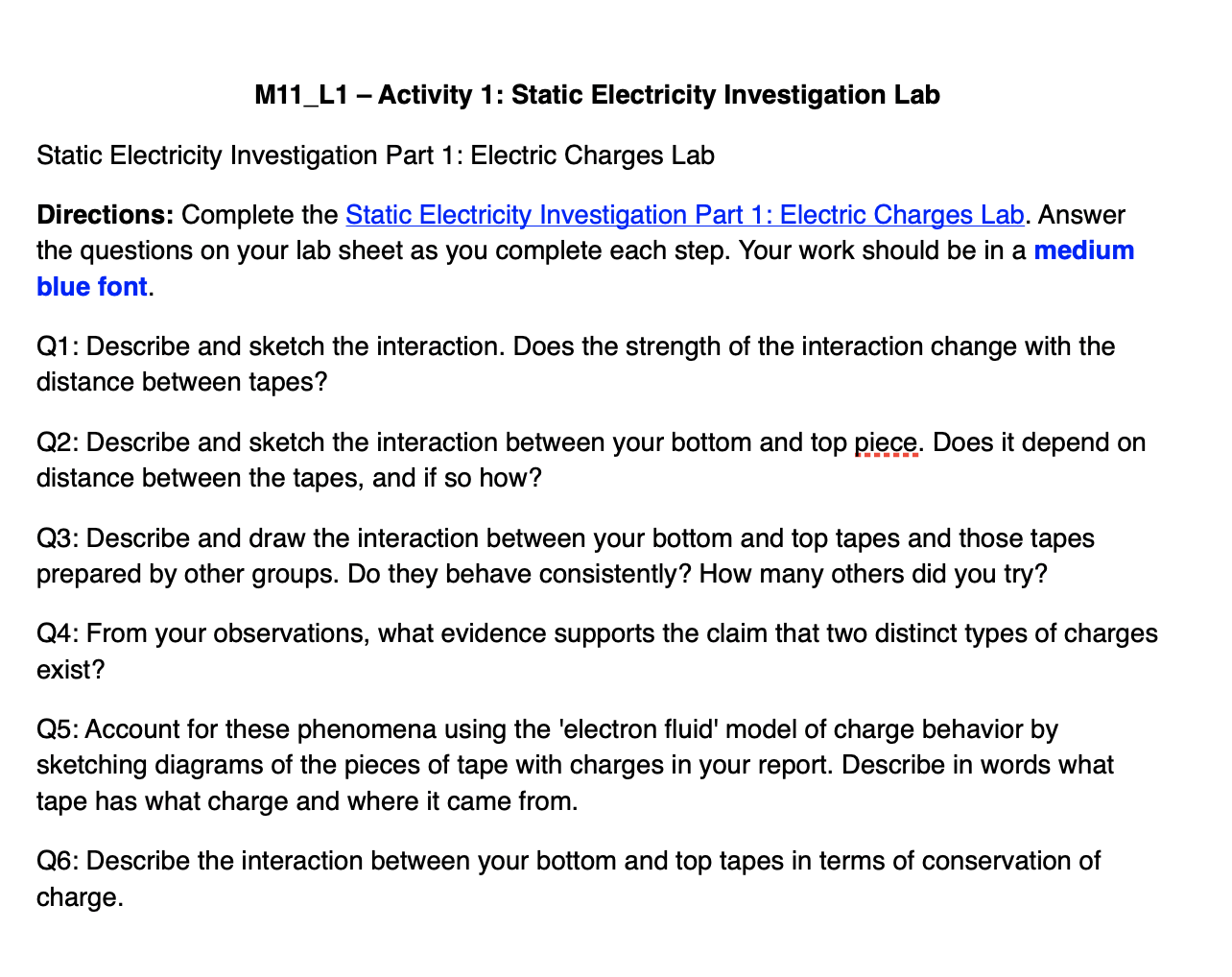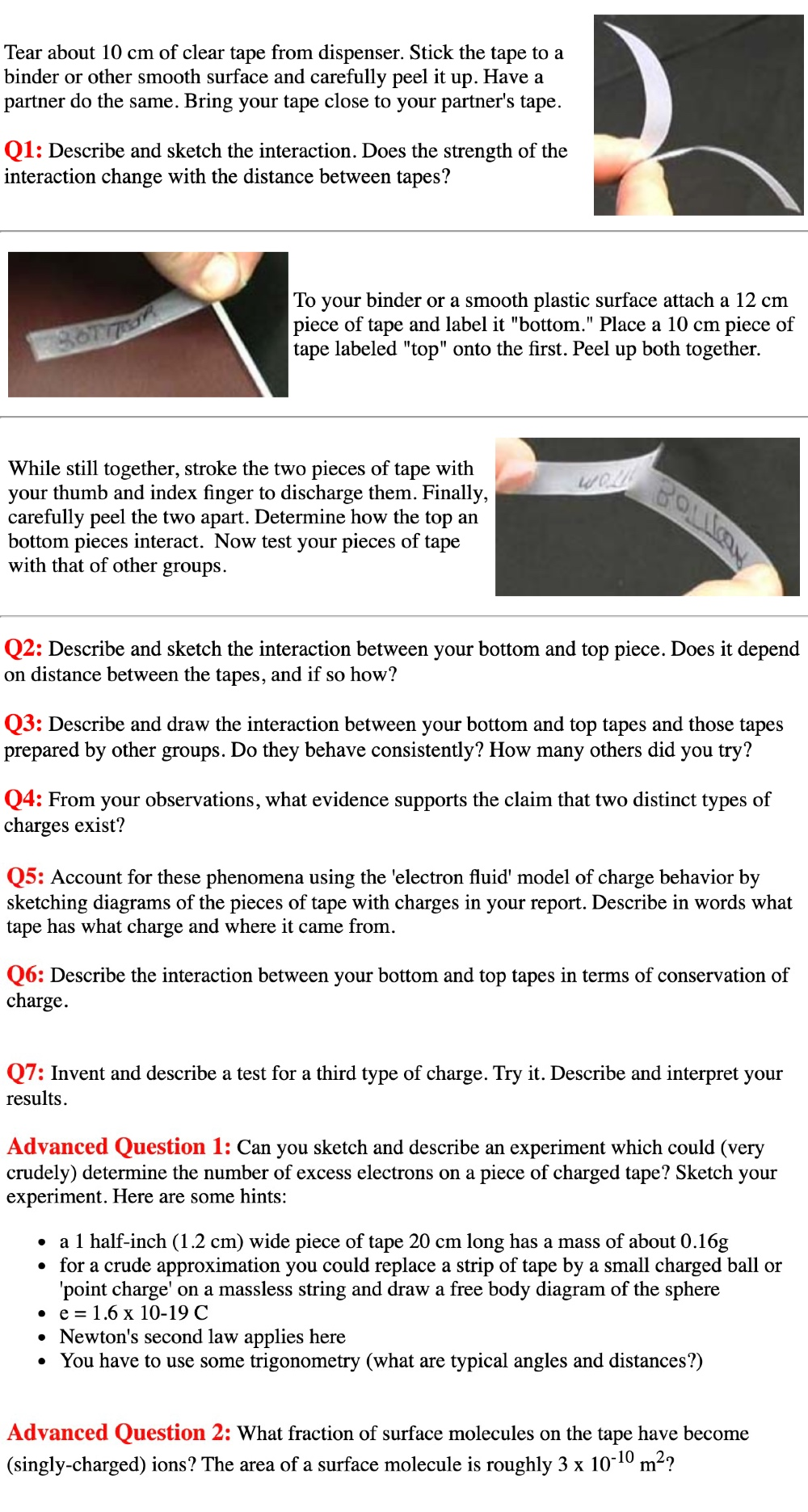M11 L1 - Activity 1: Static Electricity Investigation Lab Static Electricity Investigation Part 1: Electric Charges Lab Directions: Complete the Static Electricity Investigation Part


M11 L1 - Activity 1: Static Electricity Investigation Lab Static Electricity Investigation Part 1: Electric Charges Lab Directions: Complete the Static Electricity Investigation Part 1: Electric Charges Lab. Answer the questions on your lab sheet as you complete each step. Your work should be in a medium blue font. Q1: Describe and sketch the interaction. Does the strength of the interaction change with the distance between tapes? Q2: Describe and sketch the interaction between your bottom and top piece. Does it depend on distance between the tapes, and if so how? Q3: Describe and draw the interaction between your bottom and top tapes and those tapes prepared by other groups. Do they behave consistently? How many others did you try? Q4: From your observations, what evidence supports the claim that two distinct types of charges exist? Q5: Account for these phenomena using the 'electron fluid' model of charge behavior by sketching diagrams of the pieces of tape with charges in your report. Describe in words what tape has what charge and where it came from. Q6: Describe the interaction between your bottom and top tapes in terms of conservation of charge. Tear about 10 cm of clear tape from dispenser. Stick the tape to a binder or other smooth surface and carefully peel it up. Have a partner do the same. Bring your tape close to your partner's tape. Q1: Describe and sketch the interaction. Does the strength of the interaction change with the distance between tapes? To your binder or a smooth plastic surface attach a 12 cm piece of tape and label it "bottom." Place a 10 cm piece of tape labeled "top" onto the first. Peel up both together. While still together, stroke the two pieces of tape with your thumb and index finger to discharge them. Finally, carefully peel the two apart. Determine how the top an bottom pieces interact. Now test your pieces of tape with that of other groups. 8 Q2: Describe and sketch the interaction between your bottom and top piece. Does it depend on distance between the tapes, and if so how? Q3: Describe and draw the interaction between your bottom and top tapes and those tapes prepared by other groups. Do they behave consistently? How many others did you try? Q4: From your observations, what evidence supports the claim that two distinct types of charges exist? Q5: Account for these phenomena using the 'electron fluid' model of charge behavior by sketching diagrams of the pieces of tape with charges in your report. Describe in words what tape has what charge and where it came from. Q6: Describe the interaction between your bottom and top tapes in terms of conservation of charge. Q7: Invent and describe a test for a third type of charge. Try it. Describe and interpret your results. Advanced Question 1: Can you sketch and describe an experiment which could (very crudely) determine the number of excess electrons on a piece of charged tape? Sketch your experiment. Here are some hints: a 1 half-inch (1.2 cm) wide piece of tape 20 cm long has a mass of about 0.16g for a crude approximation you could replace a strip of tape by a small charged ball or 'point charge' on a massless string and draw a free body diagram of the sphere e 1.6 x 10-19 C Newton's second law applies here You have to use some trigonometry (what are typical angles and distances?) Advanced Question 2: What fraction of surface molecules on the tape have become (singly-charged) ions? The area of a surface molecule is roughly 3 x 10-10 m?
Step by Step Solution
There are 3 Steps involved in it
Step: 1
Static Electricity Investigation Part 1 Electric Charges Lab Q1 Describe and sketch the interaction Does the strength of the interaction change with the distance between tapes The interaction between ...
See step-by-step solutions with expert insights and AI powered tools for academic success
Step: 2

Step: 3

Ace Your Homework with AI
Get the answers you need in no time with our AI-driven, step-by-step assistance
Get Started


